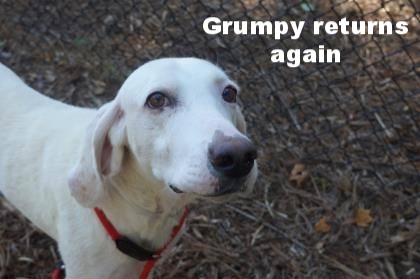Tips for Living with a Deaf Dog
Written by Connie Bombaci
Edited by Dr. Nicholas Dodman
Posted on Pet Place
“(There are) none so deaf as those who refuse to hear.”
(Adapted) Matthew Henry, Commentaries, (1708-1710)
“Who have eyes but do not see,
who have ears but do not hear”
Jeremiah 5:21
Adopting a dog into your family can certainly be an adventure. Diet, training, housebreaking and time are only a few of the considerations. Add deafness to the equation and many run for cover. A cloud of myth too often seems to hover over a dog who is found to be deaf. Some
claim that deaf dogs are dumb and unable to learn. Others maintain that they are difficult to train, moody and certain to be hit by cars. On the contrary, deaf dogs are lovable and intelligent animals who have the capacity to bring great joy and companionship into our lives. They are not in pain, nor do they need our pity. They are happy and can be socialized and trained, and like their hearing canine friends, they respond positively and with great affection when given regular and consistent doses of patience, understanding, and praise.
To begin, deafness may be the result of different reasons. Some dogs are born deaf because of their genetic makeup. Other dogs acquire deafness as a result of infection, toxicosis or old age. A thorough medical examination by a qualified veterinarian is always recommended to determine the cause, the extent, and any possible treatment. Whether the deafness is treatable or not, the bottom line is that your dog is capable of leading a full and enjoyable normal life.
Deaf Dogs: Communication is the Key to Success
Anyone acquainted with a deaf pup, child, friend, or relative knows well that establishing a solid method of communication is essential. By purchasing a pocket-sized handbook on American Sign Language (ASL), you do not have to know any ASL prior to adopting your deaf
pup. ASL is easy to use and convenient for several reasons. There are more people who know at least a few signs than you might imagine. That makes it possible for other folks to “talk” with your pup. Additionally, when you have to leave your dog with a sitter or the vet, all you have to
do is either leave the handbook with marked signs or copies of the most important signs. Your dog will then never be left in a totally “silent” world. Someone will always be able to communicate with your dog without a great deal of instruction, which could prove to be invaluable in the event of any sudden or emergency situations!
Getting Started with Your Deaf Dog
Start the same way that you would start with a hearing dog–simple repetition, patience, reward and lots of praise. The only difference in training a deaf dog is that you use your hands instead of the spoken word. Dogs are physical by nature s it will not take long before they begin to watch your hands intently for cues. You should begin with something that is a real attention grabber. “Cookie” is always a puppy pleaser. (Cookie = shape your right hand into the letter “C” and rotate the tips of the fingers on the flat palm of your left hand as if you were cutting out a cookie.) With your dog facing you, make the sign for cookie and then give him a delectable treat. Wait a few seconds and repeat. Once your pup puts together “cookie” and the reward, you will be off and running! Keep it simple and always use a sign for what you want. Before you know it, your dog will watch your hands hoping they will communicate something yummy. You can follow this by teaching your dog “sit.” Remember always to reward and praise, praise, praise. Dogs have learned as many as 65 different signs such as cookie, sit, come, stay, lay down, potty, stop and drop it. They can even learn the signs for their individual names. “Potty” (use the sign for toilet which is simply the letter “T” formed by putting your right thumb between your index and middle fingers and shake slightly) is great for housebreaking and later asking your dog if he needs to go out. Sign it every time you take him out to go potty. Remember always to be gentle, patient and very positive. Reward, never punish. The more you reward, the more the pup will respond. Enrolling in a reputable, basic obedience class is
also a great idea. Just use your hands! Socialization and Desensitization of Deaf Dogs
All dogs need to be socialized, but socialization is especially important for our deaf dogs. By allowing other people to give your dog treats from a young age, you can ensure that meeting strangers will become a wonderful experience. Desensitization to scary situations such as being startled or awakened suddenly is a must and needs to be done with care, patience and a slow pace. Practice coming up from behind and touching your dog when he is not looking at you. Wake your dog from sleep by touching the bed or area where he is sleeping or gently patting him. Begin this very gently and increase the motion slowly. This will help to
lessen the possibility of your dog being startled by sudden movement or out of a sound sleep.
Safety is Critical to Deaf Dogs
Providing for your dog’s safety is paramount. They cannot hear approaching dangers and need to be kept in secure environments. Fenced in yards are best and doors to unsupervised or unfenced yards should be kept shut. If you do not have a fenced yard, long leads provide a fun and safe way to exercise your dog in an open area. Harnesses are safest on long leads. When walking your dog, a Gentle Leader® provides the greatest control and virtually eliminates the possibility of the collar slipping over the dog’s head. Safety collars that combine a flat collar with a limited tightening feature also keep the dog from being able to back out of a collar, becoming free, and thus exposed to danger.
Be sure to include “deaf” on your dog’s nametag so he will not be misunderstood if he is ever gets lost.
Recall or Calling Deaf Dogs
Deaf dogs must to be able to see you to “hear” you. For this reason, you need to become creative in recalling your dog when his back is towards you. Inside the house, you can stamp on the floor and your dog will feel the vibration. As soon as he looks at you, motion “come” and reward as soon as he starts to come to you. You can flash a light on and off to call your dog from upstairs, downstairs, outside or from another room. You can even toss a soft toy in his direction to get his attention, and waving your arms catches his peripheral vision. Vibrating collars are also available, but be careful never to get one with the shock feature. At dusk or dark, you can use a flashlight or laser light to recall your dog. Remember to praise and reward every time your dog comes when you call him.
Exercise and the Deaf Dog
All dogs need good exercise for good health and enjoyment. Deaf dogs are no different and love to run and play. Lure coursing, Frisbee catching, jogging, agility work, and fetching are just a few of the fun things that help them feel active, build confidence and maintain happiness. Deaf dogs have also been known to bond especially close to their human families. With this special relationship comes the increased risk of separation anxiety whenever their
human is not present.
Ten Special Tips for our Special Canine Friends
1. Learn to communicate with them.
2. Always let them know when you are nearby.
3. Always be gentle.
4. Train using lots of praise and other positive reinforcements.
5. Allow them to approach a newcomer first by smelling the person’s palm or closed fist.
6. Provide outdoor fencing that is secure and essential for their safety.
7. Work with them in an established and continual training program.
8. Love and accept them with their special needs.
9. Tether them to you in the house in order to help with initial adjustment, house breaking, bonding and helping them feel safe.
10. Keep them on leashes and close to you when out on walks. Nametags should include your dog’s name and the word “deaf” in the event he is ever lost so that he is not misunderstood.
Welcoming a Deaf Canine Friend
Start by putting the “right foot forward” and your mind and heart in the best place possible. Decide from the beginning that success is the only acceptable option, and then plan to do whatever is necessary to ensure that success. The rewards will prove well worth the effort! Adopting any dog takes commitment, love, patience, and understanding. Our deaf dogs are no different. They can be welcomed by us from their world of silence with some simple signs of love.
“Whatever you do, work at it with all your heart.”
Colossians 3:23





